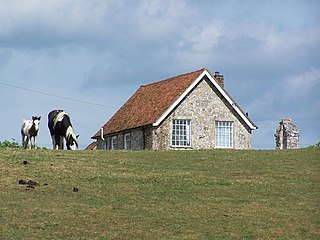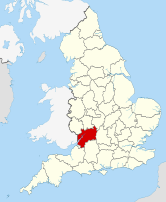Sopwell Priory was a Benedictine nunnery founded around 1140 on the site of an ancient hermitage in Sopwell, Hertfordshire, England. After the Dissolution, the priory was torn down and a Tudor manor house constructed in its place.

Monkton Farleigh is a village and civil parish in west Wiltshire, England, on high ground 3 miles (5 km) northwest of Bradford-on-Avon, and a similar distance east of the city of Bath. The parish includes the hamlets of Farleigh Wick and Pinckney Green. In the west and northwest the parish is bounded by Somerset.

Ss Leonard & Mary Catholic Church is a medieval church situated in Malton, North Yorkshire, England, now serving a parish in the Roman Catholic Diocese of Middlesbrough. It is a Grade II* listed building in the National Heritage List for England, and retains at least 24 pieces of medieval figurative carving.

Malton Priory, Old Malton, North Yorkshire, England, is near to the town of Malton. It was founded as a monastery of the Gilbertine Order by Eustace fitz John, the lord of Malton Castle. Fitz John founded both Malton Priory and Watton Priory around 1150; some sources suggest that this was an act of penance for his support for the Scots in the Battle of the Standard.

Hinton Priory was a Carthusian monastery in northeast Somerset, England, from 1232 until 1539.
Alvingham Priory was a Gilbertine priory in St. Mary, Alvingham, Lincolnshire, England. The Priory, established between 1148 and 1154, was a "double house", where religious of both sexes lived in two separate monasteries. They did not commonly communicate with one another, and there was an internal wall dividing their priory church. The superior of every Gilbertine house was the prioress, the prior being really an official of her house.
Bridgend Priory was a monastic house in Horbling, Lincolnshire, England.

Bullington Priory was a priory in Bullington, Lincolnshire, England.
Catley Priory was a monastic house in Walcott, Lincolnshire, England.
Avebury Priory was an alien house of Benedictine monks in Wiltshire, England, between the early 12th century and the Dissolution.

Ivychurch Priory was a medieval monastic house in Alderbury, southeast of Salisbury, Wiltshire, England. According to Historic England, "all that remains is a cylindrical pier with multi-scalloped capital and part of the double-chamfered arch with a respond to the west with a half-pier and capital; this is attached to the west wall of the church which retains one buttress".
Maiden Bradley Priory was a priory in Wiltshire, England. It was founded as a leper colony in 1164, and in 1189 was handed over to the Augustinian order. It was dissolved in 1536. The last prior had six children, and claimed to have special permission from the pope to keep a "whore", according to the commissioners. He also told them that the nearby Glastonbury Thorn would flower on Christmas eve, at the hour that Christ was born.
The Priory of St Mary Magdalene was a Cluniac priory in Monkton Farleigh, Wiltshire, England, in the 12th to 16th centuries.
Ogbourne Priory was a priory in Wiltshire, England, from the 12th century until the early 15th.
Salisbury Grey Friary was a friary in Wiltshire, England between the 1230s and 1538.

Upavon Priory was a small priory in Wiltshire, England.

Poulton is a village and civil parish in the English county of Gloucestershire, approximately 24 miles (39 km) to the south-east of Gloucester. It lies in the south of the Cotswolds, an Area of Outstanding Natural Beauty. In the 2001 United Kingdom census, the parish had a population of 398, increasing to 408 at the 2011 census.

Cole Park is a Grade II* listed moated country house off Grange Lane, in the parish of St Paul Malmesbury Without, about 1+1⁄4 miles (2.0 km) south of Malmesbury, Wiltshire, England. It stands on land once known as Cowfold that was owned in the Middle Ages by the Abbey of Malmesbury, and in the Tudor period was a royal stud.

Lacock Abbey was a monastery founded at Lacock, in the county of Wiltshire in England, in the early 13th century by Ela, Countess of Salisbury, as a house of Augustinian Canonesses regular. It was seized by the crown in 1539 during the Dissolution of the Monasteries under Henry VIII. It then became a country house, Lacock Abbey, notable as the site of Henry Fox Talbot's early experiments in photography.












